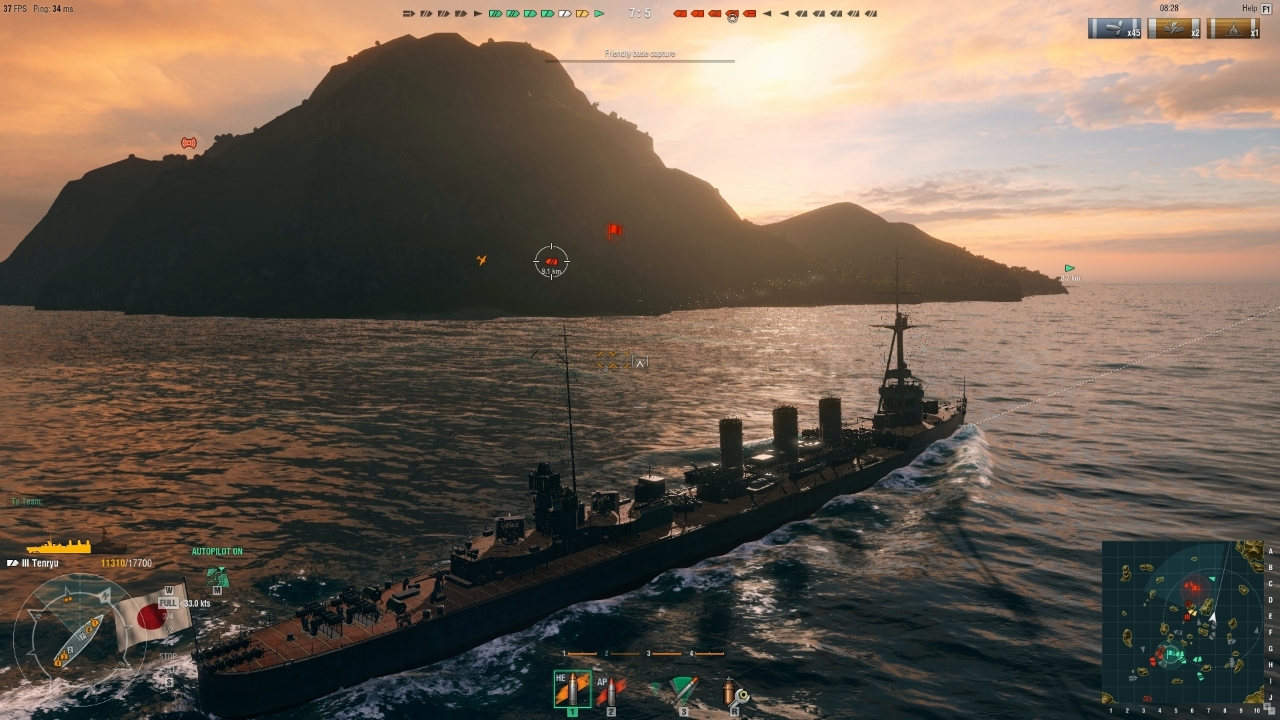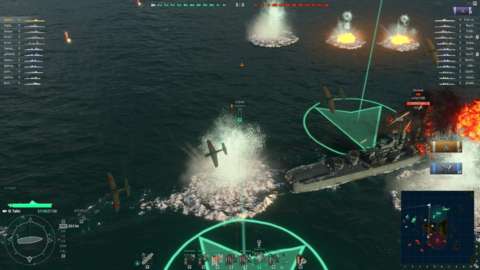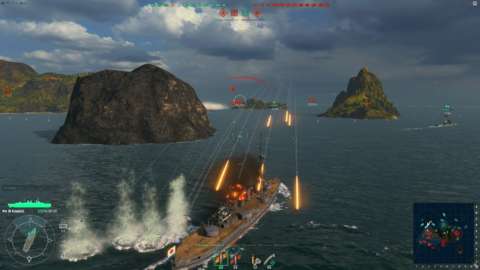My Japanese cruiser charged onward, bravely facing the surrounding maelstrom. A friendly battleship to my left billowed black smoke, its deck burning with red-orange fire as dogfighting planes buzzed overhead. To my right, I spotted an enemy cruiser several kilometers away; I lined up my guns and fired a salvo of high-explosive rounds, striking the ship and knocking out one of its primary batteries. Alas, my celebration over the successful shot was cut short by a blaring alarm indicating oncoming fire; an enemy battleship just beyond a small island had taken notice of me, sending a volley of ordnance my way. My next move could be my last.
World of Warships is a thrilling, free-to-play multiplayer action game, where you command a World War II-era ship through troubled waters. Slugs of white-hot metal tear through the sky, threatening to turn you or one of your allies’ ships into scrap . You must constantly be wary of deadly torpedoes as you circle islands and glaciers--turning hard at the helm to avoid gunfire--and keep from getting beached in the process.

The intensity of online battles is matched by the incredible variety of ships at your disposal. Dozens watercraft are available to unlock and upgrade. You begin with a small selection of lighter ships in the first tier, but soon, faster and more powerful vessels are made available. Fans of naval history will get a kick out of the impressive gathering of famous ships from the navies of both the United States and Japan. There are ten tiers to explore, most of which are categorized among four classes: destroyers, cruisers, battleships, and aircraft carriers. Destroyers are the weakest in the group, yet also the fastest, making their ability to charge by and launch a handful of torpedoes terrifying; battleships are the muscle of the fleet, heavily armored and heavily gunned; and cruisers sit somewhere in the middle, with decent firepower and armor--some (quite a few on the Japanese side) also equipped with torpedo launchers.
Unlike the other vessels, commanding an aircraft carrier requires that you know more than just maneuvering and shooting. In fact, the game seems to know this as well, since you’re unable to unlock a carrier until you have reached at least tier four. As a carrier, you play most of the match using the tactical map. Almost akin to a real-time strategy game, you build aircraft of varying types--from fighters to bombers to torpedo planes--and send them off to support allies and damage (or destroy!) enemies. It’s quite a shift from the direct ship-to-ship affair, forcing you to multitask by commanding multiple squads of aircraft, as well as making sure you keep the carrier out of the reach of enemy ships. It takes time to become acclimated to using the aircraft carrier, but I found it to be a refreshing change from the familiar mechanics. It's challenging, but fun to master.

But no matter which ship you choose, matches are composed of two competing fleets, both sides appropriately balanced among the four available classes, with aircraft carriers being the most seldom seen. In any given match you will see two at most, and sometimes none at all. Most of the enormous maps are dotted with islands large and small, providing plenty of ambush points where teams can form defensive walls and prepare for attacks. The zippy destroyers often reach these points first, covering the area in a thick smoke screen so they can safely launch torpedoes at any ship that wanders too close. Cruisers tend to play a supportive role, while imposing battleships line up in the back where they can send shells at foes over twelve kilometers away. Such a shooting distance is surpassed by higher-tier battleships, which can launch shells across more than twenty kilometers. At that point, your view of enemy ships reaches such heights that they look like toys floating in a bath tub.
Tension in battles builds slowly. The first minute or so are often wrought with silence and anticipation as you find your position, slowly scanning the horizon for any sign of the enemy fleet. Once things heat up, the fight is tense and fierce, and your very life depends on strategy, communication, and accuracy. You can’t escape death, however; eventually you’ll find yourself battered, with ruined guns and a damaged propeller. Dying on the battlefield allows you to enter spectator mode, but you can always return to port. Your ship will stay in the battle, which means having to pick another one if you plan on jumping back into the fight without delay. This, by the way, provides ample opportunity to experience other ships.
And so you fight on, because nothing quite compares to making that perfect shot at a moving enemy ship, nor to the elation felt as the ship erupts in a thunderous boom. Even during the most strategically minded fights, spontaneity can still happen, resulting in your own fiery demise or a moment of triumph. In one of my most suspenseful experiences, I had just navigated around a small island only to come face-to-face with another cruiser; as we slid by, each going in opposite directions, I lined up my torpedo launchers and--like a battle from pirate lore--fired, turning my foe into a smoldering wreck.
The intensity of online battles is matched by the incredible variety of ships at your disposal.
Combat has strategic depth, especially once you factor in the extensive list of upgrades you can apply to your ship. There are commanders to train, signal flags to fly, module enhancements to research, small fighter planes you can launch from your ship, and more. The number of changes and tweaks you can perform can be daunting. Thankfully, you are introduced to these elements gradually as you earn new levels, giving you plenty of time to experiment as you open up the higher tiers. Spending credits and experience points earned by completing matches and missions allows you to unlock new ships. Progress, however, doesn’t come quickly.
Indeed, due to its free-to-play nature, advancement in World of Warships is sluggish. At times, it felt like I was playing battles just to grind for experience points and credits, which slightly dulled the enjoyment. Still, finally nabbing that ship that has been sitting in your crosshairs brings an incredible sense of accomplishment. Naturally, this spurs you on, looking to the next tier with newfound hunger.

The game includes premium content, if you’re willing to spend a little cash for some exclusive extras and boosters. It should be said that spending actual money on World of Warships isn’t a requirement to enjoy the game. However, if you feel that the pace is too slow for your liking, you can buy a premium account, adding a fifty-percent boost to credits and experience points earned for a set amount of days. Doubloons--in-game currency that can be bought--are used to purchase exclusive ship consumables with reduced cooldown timers, as well as port slots for more ships. Spending doubloons is also the only way to remove upgrades or redistribute skill points for your commander. A small handful of exclusive ships are also available for purchase, including two Soviet-made vessels.
World of Warships’ matchmaking system worked well for much of the time I spent in-game, but there were some hiccups. Every third or fourth match I played mixed ships that were three tiers apart. Often, both sides will have matching tiers, from high to low, in order to keep things balanced; if there are a few tier-three vessels on one side, there’s a good chance the other team will have something similar. However, there is a world of difference between ships that are three tiers apart, and if they meet on the high seas, the lesser of the two typically stands a slim chance of survival. This can happen, especially when pitting divisions--groups of three--against each other, a process that seems to be determined by the highest ranking ship in a division, rather than an average of the group. This issue, however, is alleviated once you unlock ranked battles at level nine. Participation requires a tier six or seven ship, eliminating the concern over unbalanced teams.
World of Warships runs smoothly and looks gorgeous. The game features islands and archipelagos covered in forests, jungle, or mossy stone; and sometimes dotted with houses and buildings. The ships themselves are highly detailed, from the wood paneling to the rusted hulls, down to individual rivets. Battles during sunsets are bathed in amber light and long shadows, almost making it too difficult not to be distracted by the scenery. Some weather effects include dark skies and lightning, but thankfully these small storms have no effect on the surrounding ocean, so you won’t have to fight both your enemies and nature at the same time.

Though pretty, the game does come with a few annoying visual bugs, along with some glitches. Every so often, black boxes appear under the navigation markers on your strategic map. However, this is more annoying than game-breaking. Also, ship details sometimes have a tendency to pop in and out of existence. On occasion, binocular mode, which zooms your vision to your ship’s maximum range, gets stuck below the water-line, forcing you to slap at the keys a few times to dislodge it. This is not what you want to happen during an intense firefight.
World of Warships does have a few small hitches, but they're easily manageable. Ultimately, the excitement that comes from commanding powerful ships during explosive battles on the high seas overshadows these faults. The thrills that await, along with the promise of unlocking advanced ships down the road, make World of Warships an enticing expedition into the sometimes turbulent waters of free-to-play games.